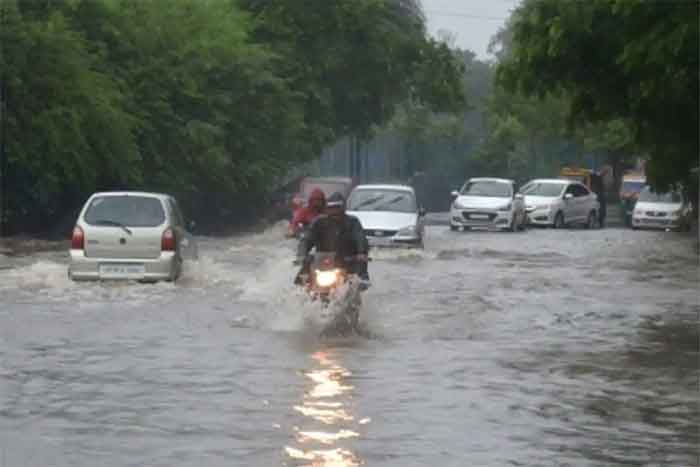In the bustling roadside market around the small, quaint and laid-back railway station of Jharkhand’s Madhupur, where locals, passenger and express trains crisscross the railway tracks towards Asansol and Burdwan to Howrah, or beyond to Patna and Delhi, no one wears masks.
It’s a predictable and typical syndrome in small-town India, as if this global pandemic has never existed. With songs in the local dialect booming all over, and crowds thronging the steaming pakora and tea shops on a cold evening, almost everyone is unanimous: Covid indeed does not exist in Madhupur or its neighboring rural and tribal areas they claim. Not a single case has been reported. So, no one wears masks. They inhale the cold night wind. And the sweet, syrupy tea is delicious and hot.
 Ajay is educated and he used to drive an auto. Now he drives a small private taxi. His family does agriculture, and has a little grocery store at Fatehpur, a village inhabited by Santhals. He, like many of his friends, is fully vaccinated, though he insists that Covid is not a scare around this region. “And, yet, we should all get fully vaccinated,” he says. “This is a deadly disease.”
Ajay is educated and he used to drive an auto. Now he drives a small private taxi. His family does agriculture, and has a little grocery store at Fatehpur, a village inhabited by Santhals. He, like many of his friends, is fully vaccinated, though he insists that Covid is not a scare around this region. “And, yet, we should all get fully vaccinated,” he says. “This is a deadly disease.”
Across Madhupur, beyond into the slope downhill in the tribal hinterland of Fatehpur, surrounded by vast expanses of green and empty landscape with tall, ancient trees, through pucca and kuccha roads and bylanes, under a full moon night, we enter a quiet and sublime Santhal village, Fatehpur, with the smell of ‘Raat ki Raani’ flooding the moon-lit landscape. The night air is crisp and chilly, and the water we get from the community hand-pump is cold and refreshing: the famous, therapeutic, magical air and water of Madhupur.
The morning brings the local folk to a community hand-pump under a huge peepal tree. Little Shibani is filling water in a big utensil. She smiles easily. This is the post-harvest season – people are cutting the crops or crushing them. Most men and women have sickles in their hands. Women and young girls walk long distances, up and down, carrying grain from their fields on their heads. In the open courtyards, women are working all day cleaning the grain.
 It’s a sunny day. A child has been born in the locality, so there is community festivity all day with food, songs and drink. Many tribal farmers are relaxing. Men join the festivity in the day-time. The happy collective of women join after dusk.
It’s a sunny day. A child has been born in the locality, so there is community festivity all day with food, songs and drink. Many tribal farmers are relaxing. Men join the festivity in the day-time. The happy collective of women join after dusk.
At a make-shift thatched shop, fresh khajoor toddy and hot pakoras are being served early in the morning. Rs 10 for the fresh juice in a big bowl. Once fermented under the sun, it becomes intoxicating toddy which can make you tipsy. Hardened farmers, their young ones, travelers passing by on motorbikes and cycles, – they drop by to chat and share notes. And share a drink.
The tribal village of Fatehpur is dominated by Santhals – friendly, hardworking, laid-back, lyrical and musical. Almost all of them have got their single dose of vaccination. Because Covishield has a long waiting span, they are waiting,
“We have not suffered from Covid. However, we know the economic and social devastation it has caused all around. Hence, we are all for vaccination” says a resident.
There is a small community of Yadavs, who rear cows and buffalos, and trade in milk. They live a shared life, within their community and with the friendly Santhals in the area for decades, and they marry among each other. Baleshwar Yadav treks a few kilometers to distribute fresh milk in the morning. His son takes a local train at the crack of dawn to distribute milk across to nearby Giridih, also in Jharkhand. “It was tough during the pandemic and the lockdown. There were no trains, no transport, and the police was not allowing movement. We had to get permits to distribute milk. We had to struggle really hard during those days. Things seem to be improving now. I only hope that the lockdown does not return.”
Though agriculture is the mainstay here, it is dependent on annual rain. People grow vegetables on their land, but it is not enough for daily survival. Most cultivable land is small in size. The humble village just about survives on a minimalist logic of sustenance. Hence, the Santhals and locals often have to choose to do extra miscellaneous work in the towns nearby for survival.
 Most of them are not educated, and hence they have to do manual labour — daily wage and make-shift work as loaders, mechanics, construction workers, etc. Though there is no mass migration, many depend on daily jobs, of which there was a shortage during the pandemic.
Most of them are not educated, and hence they have to do manual labour — daily wage and make-shift work as loaders, mechanics, construction workers, etc. Though there is no mass migration, many depend on daily jobs, of which there was a shortage during the pandemic.
Despite the green landscape, a large mass of the empty land is fallow and rocky, and it is impossible to grow anything on that land. Villagers grow whatever they can in little strips of fertile land they own. One old tribal villager has worked for almost a decade to dig endlessly on a fallow and rocky strip of land to create a space for agriculture. He is still digging, but he is proud of his achievement. “This land is our mother. We have to nourish it with our sweat and blood,” he said”.
“It was really difficult to survive on one crop. We did not have money to buy vegetables, essential commodities or cooking oil. Cooking gas is so expensive that we cook with wood. And there was no transport during the lockdown. The markets and construction work were shut, the small industries had put down their shutters. It was tough,” said a young Santhal villager.
In pre-Independence times Madhupur was a magnet for well-off city folks in search of good air, water and quiet surroundings amidst pristine nature. For the ‘outsider’, tourist, or partial and occasional settler, especially the elite and bhadralok Bengalis, who arrived with great joy and anticipation during the holiday seasons, ‘nature’ meant, ‘aawo hawa’ – the ecological atmospherics of good health, good for convalescence from acute or persistent illness and speedy recovery from a serious ailment.
Indeed, like even a short spell around the sea and its salty air is legendary in the West for both mental and physical recovery after a bout of bad health or existential suffering, Madhupur became famous as a natural and organic health resort of some sort. Rich Bengalis and others would build ‘Bagaan Baaris’ – sprawling homes with lush green gardens, and they would arrive during the holiday and festive seasons – not because there were medical, natural or auyurvedic centres of treatment, as in Kerala, but because of the legendary ‘aawo hawa’ of Madhupur.
It was simply because this place has been famous for its magical water and its clean, pure air. The story was that you come to Madhupur in bad health, and the air and water will treat you with its gentleness and beauty, and you will go back to the Mahanagar of Calcutta, fully recovered and resurrected. Such was the miracle of Madhupur.
The fame and the legend remain even today. The water and the air are still pristine and pure. And, yet, like everything, a lot has changed. And no one knows it better than the beautiful community of Santhal adivasis who live in sprawling mud houses with huge open-to-sky courtyards in the nearby rural interiors surrounded by vast, green expanses.
So, the locals will still tell you: “Well, the bhadralok Bengalis are not coming from Kolkata in the same manner as in the past, many of their Bagaan Baaris have been sold or lie in ruins, but, let us assure you – the magic of the air and water of Madhurpur remains unmatched.”
Amit Sengupta is Executive Editor, Hardnews and a columnist, currently based in Kolkata














































